The city of Toronto offers many photographic opportunities, and doing a general Toronto post would be incredibly difficult. So instead, I will try to break it down into bite-sized pieces of history. So having to go into the city for an appointment at Sick Kids and being close to my birthday, we all headed out for a lovely walk over to one of the best examples of Victorian-era industries that survived in the city, the Distillery District.

Konica-Minolta Maxxum 70 – Minolta Maxxum AF 28mm 1:2.8 (Yellow-12) – Arista EDU.Ultra 100 @ ASA-100 – Fotospeed FD10 (1+9) 8:00 @ 20C
The history of the creation of alcohol dates back to the earliest parts of human history, but distilling spirit alcohol is something a little newer. First recorded in the 13th Century, Italian monks would distil spirit alcohol from wine. The process quickly spread through various monastic orders. In contrast, history is foggier on the process where grains are fermented and then distilled, using rye, wheat, barley and corn. By the 15th century, the process had reached both Scotland and Ireland. It should also be noted that the spirit alcohols of the day were not aged, incredibly strong, and raw tasting. The disillusion of the monasteries in England by King Henry VIII brought distillation into the public sphere as the monks found themselves in the civilian population with a skill and a need for income. Soon official distilleries were opening up; the problem was that a malt tax in 1725 drove most distilling underground, with Scottish distillers working at night to hide the smoke from their stills, coining the term moonshine. As colonisation continued in North America, distilling quickly followed; in most major settlements with farmland and a mill, distilling soon followed. Even George Washington operated a distillery at Mount Vernon, and whisky was used as currency during the American Revolution. In Canada, the earliest distillery was found in Quebec City in 1769. Through the first half of the nineteenth century, several things improved the distilling and brought whisky close to what we know today. The introduction of a license fee, the development of the Coffey Still, and the start of ageing in charred barrels. The creation of whiskey exploded. In York (Toronto), James Wort and William Gooderham established a mill at the mouth of the Don River; operations opened in 1831. The two men saw an opportunity in 1837 when a massive wheat surplus had them start a small distilling operation. This quickly grew into the primary business, and in 1859 the construction of a new proper distilling complex began. Their location allowed them access to the Toronto Harbour and the growing network of railways that radiated out from Toronto. The distillery produced some 3.18 million litres of spirit, which would only grow. Ageing whisky took place in charred white oak barrels, which did slow down the finishing process, but produced a smoother, mellow-tasting spirit, which also gives the distinct brown colour. Regarding spirit production, Gooderham & Wort became one of the largest in Canada—completing a new headquarters at Front & Church, the iconic Toronto Flatiron, and even sponsoring a series of narrow gage railways to aid in bringing in raw materials. The 20th Century started troubles for the distillery, and the First World War saw the company shift some production to anti-freeze. The enacting of temperance laws of 1916 forbids the sale of alcohol but not the production. So the distilling continued, with the booze often ending up in the United States and Quebec and through smugglers back in Ontario. Gooderham & Worts would end up in the hands of Hiram Walker in the 1920s, and their (in)direct involvement with whisky smuggling resulted in a massive tax evasion fine in 1928. Surprisingly the distillery remained intact and operated until its closure in 1990. Although a historical designation in 1988 prevented demolition. Through the 1990s, many movies and television shows were filmed in the closed distillery, and urban explorers prowled the space. In 2001 the old plant was acquired. by Cityscapes Holdings Inc, the goal is to create a dedicated arts district. And when the new district first did fit that bill, with the many buildings converted to studios and galleries. And while it has changed since then, it remains a great surviving example of Victorian industries in Canada. And distilling is still present, with Mill Street Brewing, Spirit of York Distilling, and IZUMI, a Sake brewery.

Konica-Minolta Maxxum 70 – Minolta Maxxum AF 28mm 1:2.8 (Yellow-12) – Arista EDU.Ultra 100 @ ASA-100 – Fotospeed FD10 (1+9) 8:00 @ 20C
Konica-Minolta Maxxum 70 – Minolta Maxxum AF 28mm 1:2.8 (Yellow-12) – Arista EDU.Ultra 100 @ ASA-100 – Fotospeed FD10 (1+9) 8:00 @ 20C
Konica-Minolta Maxxum 70 – Minolta Maxxum AF 28mm 1:2.8 (Yellow-12) – Arista EDU.Ultra 100 @ ASA-100 – Fotospeed FD10 (1+9) 8:00 @ 20C
Konica-Minolta Maxxum 70 – Minolta Maxxum AF 28mm 1:2.8 (Yellow-12) – Arista EDU.Ultra 100 @ ASA-100 – Fotospeed FD10 (1+9) 8:00 @ 20C
I went into this month’s subject with only a general idea of what I wanted to capture. The one thing that I did put in my head forefront was a building that wasn’t a part of the distillery district proper, but rather linked to the distillery. That building is the Toronto Flatiron building, built in the 1890s and predating the even more legendary New York building, the Gooderham building served as the distillery’s headquarters until the entire place shut down and survived the urban renewal the lost the city many architectural treasures. From there it was a matter of filling the other twenty-three frames. Thankfully being in the city on a Friday rather than a weekend the district was busy but not as busy as a Saturday with equally nice weather. I knew the featured photo had to include one of the many surviving nameboards within the district. One nice surprise was finding a restored ghost sign on our way into the district. Thanks to taking a different route into the space. From there I trusted my gut to include things that I enjoyed. Taking a more big-picture approach to the entire set.

Konica-Minolta Maxxum 70 – Minolta Maxxum AF 28mm 1:2.8 (Yellow-12) – Arista EDU.Ultra 100 @ ASA-100 – Fotospeed FD10 (1+9) 8:00 @ 20C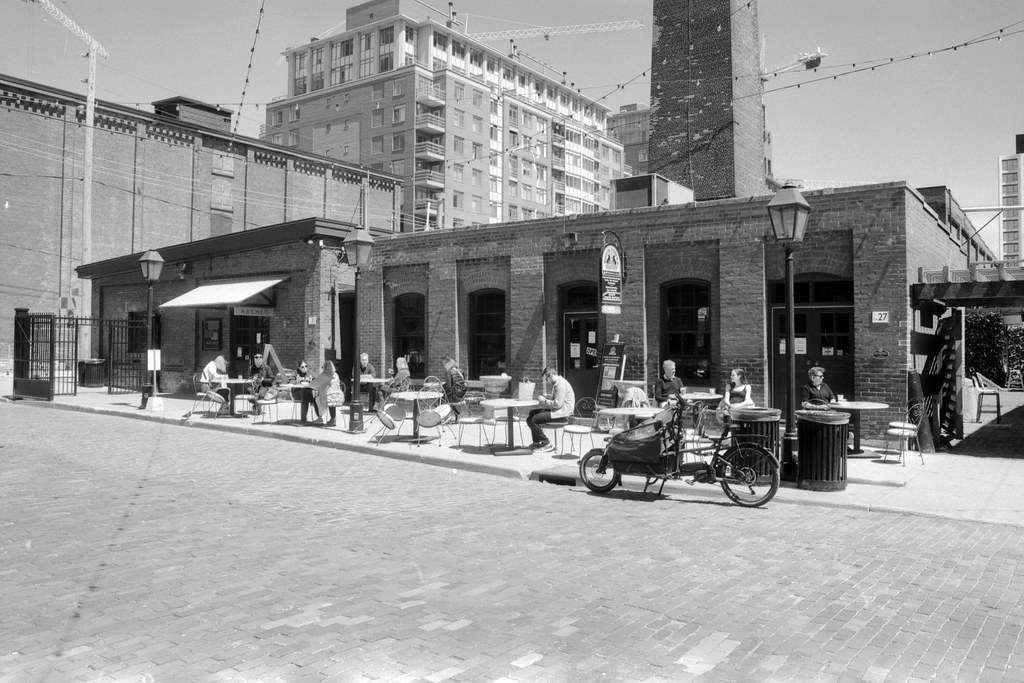
Konica-Minolta Maxxum 70 – Minolta Maxxum AF 28mm 1:2.8 (Yellow-12) – Arista EDU.Ultra 100 @ ASA-100 – Fotospeed FD10 (1+9) 8:00 @ 20C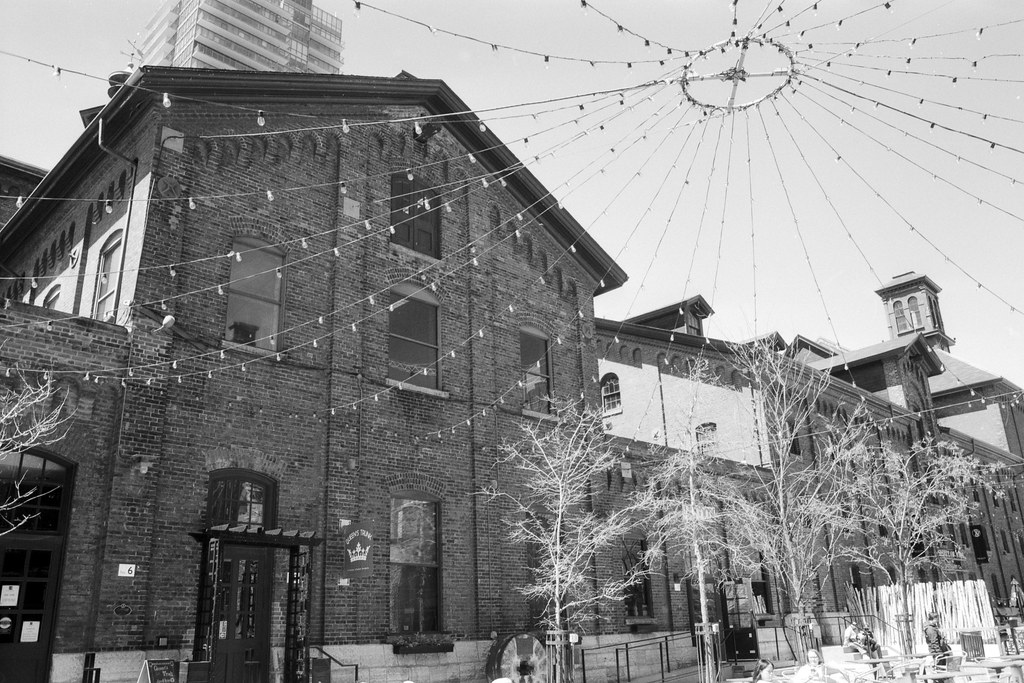
Konica-Minolta Maxxum 70 – Minolta Maxxum AF 28mm 1:2.8 (Yellow-12) – Arista EDU.Ultra 100 @ ASA-100 – Fotospeed FD10 (1+9) 8:00 @ 20C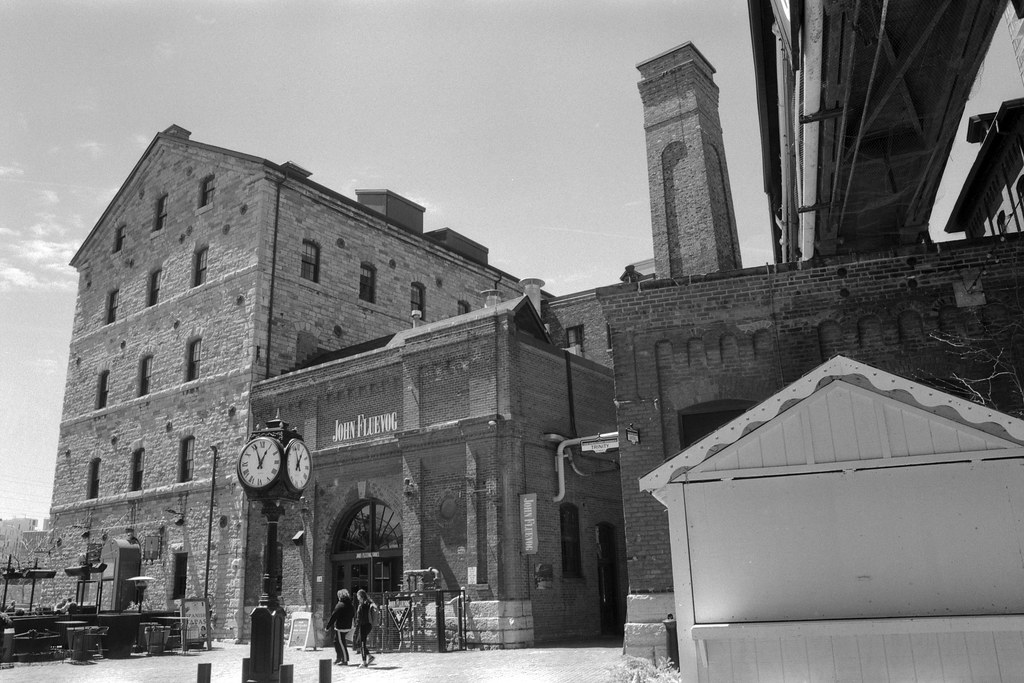
Konica-Minolta Maxxum 70 – Minolta Maxxum AF 28mm 1:2.8 (Yellow-12) – Arista EDU.Ultra 100 @ ASA-100 – Fotospeed FD10 (1+9) 8:00 @ 20C
I knew this might happen, but the lens that I had gotten with teh camera started to act up last month. The 28-100mm isn’t know for its build quality and I started to hear a bit of a grinding noise from the lens when it was focusing. And when you hear grinding and you know the things internals are plastic you get it looked at. And knowing I was heading to an area where I needed that 28mm focal length I didn’t want the restrictions of the 35-70/4. I ended up throwing on the first available lens I had without digging too deep, the trusty 28/2.8. This lens was part of the original Maxxum kit I got as a gift from another photographer who found their 7000 and some lenses (35-70, 50, 28, and 70-210). I also made a point to toss on a yellow filter to help cut down some of the blue light. And you know it all worked, but I also think the developer gave some excellent results. This month I went with Fotospeed FD10, a new-to-me developer I ran across on another person’s IG feed and sourced a bottle. This is an elevated general-purpose developer that did an excellent job adding some excellent tonality with a medium-to-high contrast. The one surprising this is that it softened up some of the edges, but not too much.
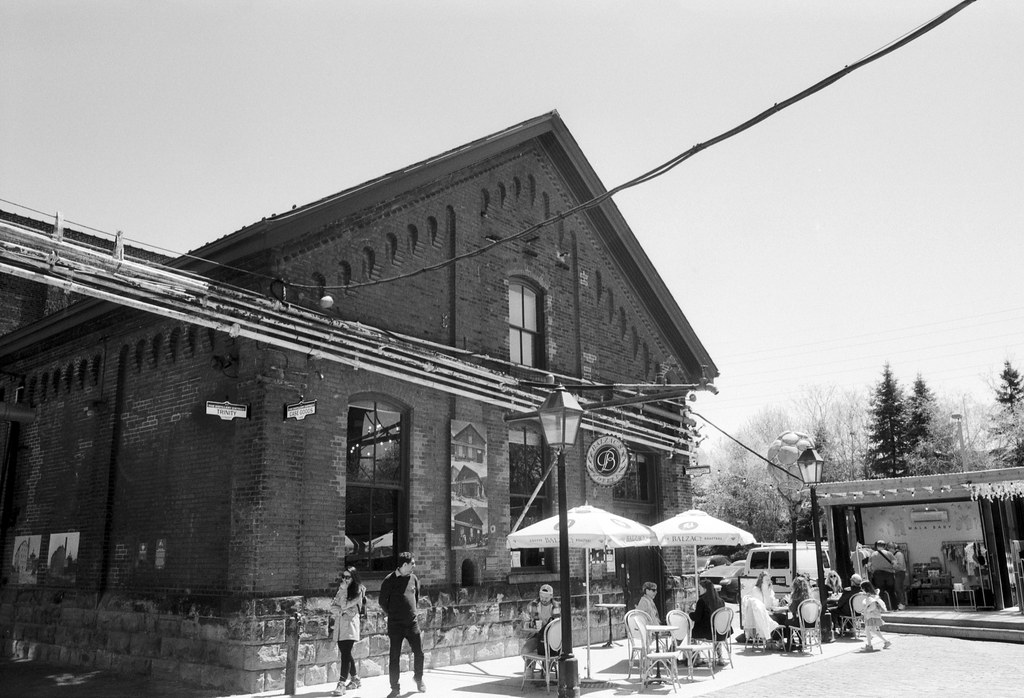
Konica-Minolta Maxxum 70 – Minolta Maxxum AF 28mm 1:2.8 (Yellow-12) – Arista EDU.Ultra 100 @ ASA-100 – Fotospeed FD10 (1+9) 8:00 @ 20C
Konica-Minolta Maxxum 70 – Minolta Maxxum AF 28mm 1:2.8 (Yellow-12) – Arista EDU.Ultra 100 @ ASA-100 – Fotospeed FD10 (1+9) 8:00 @ 20C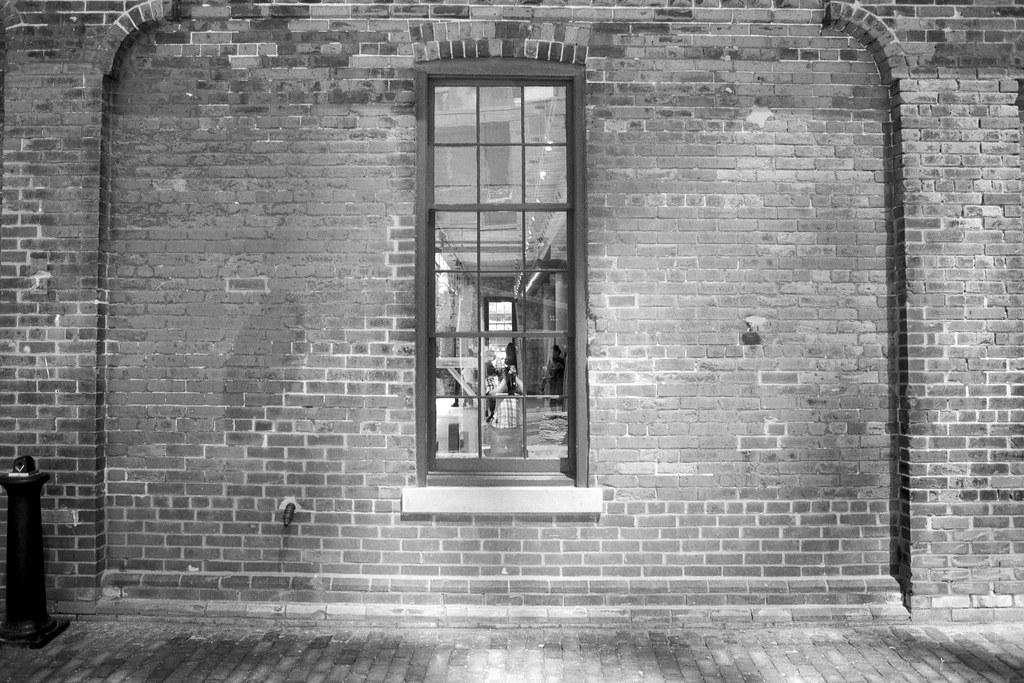
Konica-Minolta Maxxum 70 – Minolta Maxxum AF 28mm 1:2.8 (Yellow-12) – Arista EDU.Ultra 100 @ ASA-100 – Fotospeed FD10 (1+9) 8:00 @ 20C
Konica-Minolta Maxxum 70 – Minolta Maxxum AF 28mm 1:2.8 (Yellow-12) – Arista EDU.Ultra 100 @ ASA-100 – Fotospeed FD10 (1+9) 8:00 @ 20C
The distillery district is well worth a visit if you come to Toronto. While its character and contents have changed since it first opened, you can see a glimpse of the city’s distilling history and art scene. Plus, with places like Mill Street, IZUMI, and Spirit of York, you can get a good example of the craft brewing and distilling scene. Although Mill Street is much more commercial now that a larger brewery bought it up. Next month for the first time in several years, I’m going on vacation, mainly to visit family, but a bit of photography is thrown in. I’m heading out west to the city of Regina!
Nice series of images Alex!
Thank You!
Lovely shots Alex as always!! The wide angle appeals so much to me and I love the architecture.